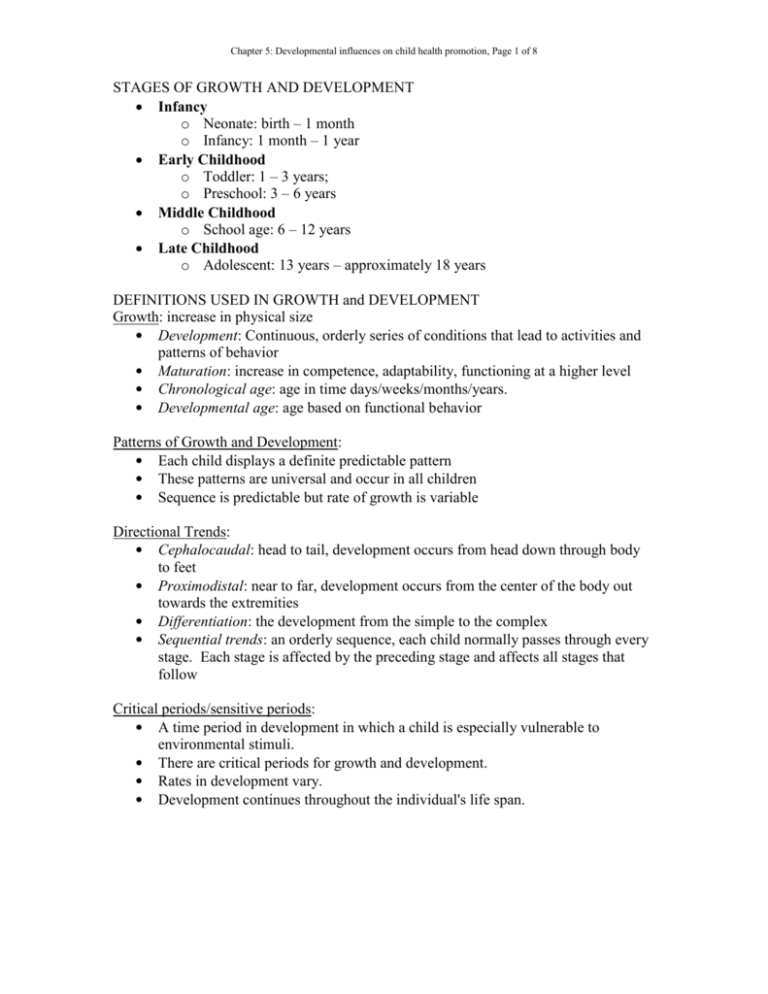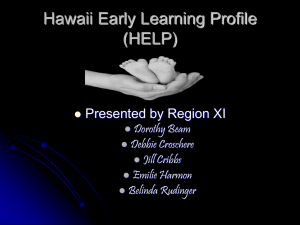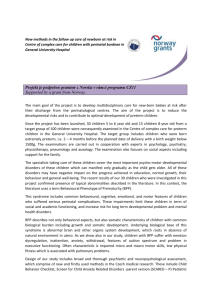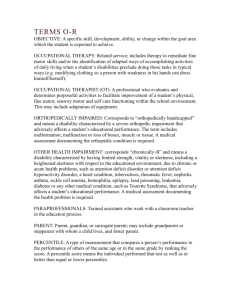Child Development: Stages, Theories, and Influences
advertisement

Chapter 5: Developmental influences on child health promotion, Page 1 of 8 STAGES OF GROWTH AND DEVELOPMENT Infancy o Neonate: birth – 1 month o Infancy: 1 month – 1 year Early Childhood o Toddler: 1 – 3 years; o Preschool: 3 – 6 years Middle Childhood o School age: 6 – 12 years Late Childhood o Adolescent: 13 years – approximately 18 years DEFINITIONS USED IN GROWTH and DEVELOPMENT Growth: increase in physical size • Development: Continuous, orderly series of conditions that lead to activities and patterns of behavior • Maturation: increase in competence, adaptability, functioning at a higher level • Chronological age: age in time days/weeks/months/years. • Developmental age: age based on functional behavior Patterns of Growth and Development: • Each child displays a definite predictable pattern • These patterns are universal and occur in all children • Sequence is predictable but rate of growth is variable Directional Trends: • Cephalocaudal: head to tail, development occurs from head down through body to feet • Proximodistal: near to far, development occurs from the center of the body out towards the extremities • Differentiation: the development from the simple to the complex • Sequential trends: an orderly sequence, each child normally passes through every stage. Each stage is affected by the preceding stage and affects all stages that follow Critical periods/sensitive periods: • A time period in development in which a child is especially vulnerable to environmental stimuli. • There are critical periods for growth and development. • Rates in development vary. • Development continues throughout the individual's life span. Chapter 5: Developmental influences on child health promotion, Page 2 of 8 FACTORS THAT INFLUENCE GROWTH and DEVELOPMENT 1. Genetics: family history of diseases or impairment that may be inherited. Chromosomes carry genes that determine characteristics, intellectual potential and personality traits. 2. Nutrition: The greatest influence on physical growth and development, adequate nutrition provides essentials for physiologic needs, promotes health and prevents illness. 3. Prenatal/environmental factors: nutrition of mother, in utero exposure to drugs, alcohol, smoking, infection, environmental toxins. 4. Family and community: stimulating family environment helps a child reach their full potential. Family support, structure and community involvement and support influences the child’s environment and helps promote growth and development. 5. Cultural factors, customs and traditions. 6. Socioeconomic status is the single most important adverse factor in health and the growth and development of a child. Some lower socioeconomic families lack the resources to provide a safe, stimulating environment that promotes optimal growth. • • Biological growth/physical development – Neurological maturation: Nervous system grows rapidly in utero, two periods of very rapid growth: 15-20 weeks and 30 weeks. It is believed that no new nerve cells appear after the 6th month of fetal life. – Metabolism: BMR: basal metabolic rate. Highest in newborn, correlates to surface area. BMR determines caloric requirements. BMR changes continuously and is very high during illness Temperature – Body temperature reflects metabolism. Infants/young children very susceptible to temperature changes, temp responds to environment, activity, crying. Infections can cause high, rapid increase in temp – Thermoregulation. One of the most important adaptations from intrauterine to extrauterine life. In the healthy term newborn hypothermia can result quickly and cause hypoglycemia and metabolic acidosis. Newborns have decreased amounts of subcutaneous fat, predisposing them to hypothermia TEMPERAMENT The way a person deals with life. From birth there are notable differences in children in the way they respond to others and how others respond to them. The EASY child: easy-going, predictable behavior The DIFFICULT child: active, irritable, unpredictable behavior SLEEP Needed for the repair and recovery of tissues. Each child has variable sleep patterns. Chapter 5: Developmental influences on child health promotion, Page 3 of 8 We cover ERIKSON and PIAGET PSYCHOSOCIAL DEVELOPMENT: ERICKSON **MOST IMPORTANT STAGE TO KNOW IS 1ST STAGE Trust vs. Mistrust Birth – 1 year (neonate-infant) The major task during the first year of life is developing a trust of other people. In the case of an infant, they are completely dependant on others to meet their every need. Mistrust develops when these basic needs are not met (feeding, diapering, warmth) or are inconsistent. Mistrust in this stage can have a profound effect on a child. Autonomy vs. shame and doubt 1-3 years (Early childhood: toddler) Child is beginning to experience the ability to control self, their activities and their environment; they are acquiring and mastering new skills at a rapid rate. At this stage they begin to develop autonomy and like to “do it myself”. If they are continually not allowed to do thing “by myself” they begin to feel doubtful of their abilities and begin to feel shame. If they successfully pass through this stage they develop self confidence and will power. Initiative vs. guilt 3-6 years (Early childhood: pre-school) At this stage a child is extremely busy exploring, learning about their world. They have lots of ideas, thoughts and new activities. They are developing a conscience. Initiative is demonstrated when the child is able to formulate and carry out new ideas. If they successfully pass through this stage they develop self-confidence, initiative, self-esteem, direction and purpose. If they are criticized for their ideas and actions it leads to a feeling of guilt. Industry vs. inferiority 6-12 years (Middle childhood: school age) During the middle years of child hood they display intense development of new interests and involvement in many activities. They are learning to follow the rules at home in school and in social situations. They are acquiring the skills to read, write, perform math, and handle a variety of social situations. If they successfully pass through this stage, they gain confidence and enjoy learning, if too much is expected of them at this stage or if they are compared to others (siblings) it may lead to feelings of guilt and inadequacy if they cannot meet expectations. Identity vs. role confusion 12-18 years (Late childhood: adolescent) A period of rapid physical change, marked by preoccupation with physical appearance. Continually redefining self, peers, family and society. Experiments with many different roles and peers/groups are very important (more important than family). If they are successful in this stage they develop confidence in their identity and place in the world and have an optimistic view of the world. Chapter 5: Developmental influences on child health promotion, Page 4 of 8 COGNITIVE DEVELOPMENT- PIAGET Sensorimotor Birth – 2 years Learning though senses and motor activity. Progresses from primitive reflex activities to imitated behaviors. Develops sense of cause and effect. Curiosity, experimentation and exploration result in the learning process. Object permanence is fully developed. Preoperational 2 years – 7 years Begins to form symbolic thought, exhibits egocentrism and is unable to put oneself in place of another, increased ability o use language. Can only concentrate on one characteristic of an object at one time. Concrete operational 7-11 years Thoughts are becoming more concrete and logical. Very concrete thinkers hot or cold, black or white, no warm or gray. Able to classify and sort facts, is able to problem Formal operations 11 years- death Child is able to understand abstract and unobservable concepts; very adaptable and flexible. Can use a scientific approach to problem solve. Is able to conceive the distant future SITTING UP 2 months: needs assistance; lifts head and chest when prone 6 months: can sit alone in the tripod position; no head lag when pulled to sit 8 months: can sit without support and engage in play GROSS MOTOR SKILLS • The acquisition of gross motor skills precedes the development of fine motor skills. • Both processes occur in a cephalocaudal fashion – Head control precedes arm and hand control – Followed by leg and foot control. GROSS MOTOR DEVELOPMENT Newborn: barely able to lift head 6 months: easily lifts head, chest and upper abdomen and can bear weight on arms Review HEAD LAG milestones. FINE MOTOR DEVELOPMENT Pincher vs. palmar grip FINE MOTOR – INFANT Newborn: very little control; objects will be involuntarily grasped and dropped 6 months: palmar grasp; uses entire hand to pick up an object 9 months: pincer grasp, can grasp small objects using thumb and forefinger; that’s when you start feeding little table foods 9-12 months: stands by holding on to objects for support 13 months: walking on own; occurs as early as 9 months or as late as 15. As long as they are trying to move somehow it is not an immediate cause for concern. Chapter 5: Developmental influences on child health promotion, Page 5 of 8 AMBULATION 9 months: crawl and/or “cruising” - moving by holding onto things 1 year: stands independently from a crawl position 13 months: walk (generally) and toddle quickly 15 months: can run LANGUAGE DEVELOPMENT All children are born with the ability and mechanism needed to develop speech and language skills but they will not speak spontaneously. They must have the environmental stimulus of the human voice to imitate. Speech development varies from child to child and is directly related to neurological competence and cognitive development. Crying and gestures are a child’s first method of communication, when speech begins the gestures recede but never disappear. At all times children’s receptive language is greater than their expressive language. LANGUAGE MILESTONES Milestone Understands “dada”, “mama” Says dada, mama + 2 other words, imitates animal sounds 4-6 word vocabulary, points to desired objects 7-20 word vocabulary, points to 5 body parts 2 word combinations 3 word combinations Age attained 10 months 12 months 14 months 18 months 20 months 24 months PLAY – THE “WORK” OF CHILDREN (5-6 YEARS OF AGE) Solitary Play: playing alone with toys different from the ones being used by other children in the room. They enjoy the company of other children but do not make any effort to talk with them or play with them, very focused on their own activity. Parallel play: playing independently but among others (beside them but not together). No group association, a characteristic of toddlers. Associative play: children playing together in a similar activity. TODDLER: safety becomes a problem as the toddler becomes more mobile. FINE MOTOR – TODDLER 1 year: transfer objects from hand to hand 2 years: o can hold a crayon and color vertical strokes; o turn the page of a book; o build a tower of six blocks FINE MOTOR – OLDER TODDLER 3 years: copy a circle and a cross – build using small blocks 4 years: use scissors, color within the borders Chapter 5: Developmental influences on child health promotion, Page 6 of 8 5 years: write some letters and draw a person with body parts Chapter 5: Developmental influences on child health promotion, Page 7 of 8 DENVER DEVELOPMENT EXAM – just know what it is, what the parameters are (25%-75%), and what happens when a child falls outside those parameters. PRE-SCHOOLER: FINE MOTOR AND COGINITIVE ABILITIES Buttoning clothing Holding a crayon/pencil Building with small blocks Using scissors Playing a board game SCHOOL AGE: GROSS MOTOR 8-10 years: team sports 10 years: match sport to the physical and emotional development SCHOOL AGE: FINE MOTOR Writing skills improve Fine motor is refined Fine motor with more focus o Building: models-Legos® o Sewing o Musical instrument o Painting o Typing skills o Technology: computers SCHOOL AGE: COGNITIVE Child has greater ability to concentrate and participate in self-initiating quiet activities that challenge cognitive skills, such as reading, playing computer and board games. ADLOLESCENT As teenagers gain independence they begin to challenge values Critical of adult authority Relies on peer relationship Mood swings especially in early adolescents Relationships Sexuality – STDs /AIDS Substance use and abuse Gang activity Driving QUESTIONS FOR DEVELOPMENTNAL SCREENING “Do you have any concerns about your child’s vision or hearing?” “What changes have you seen in your child’s development lately?” Parents are usually right when they say something “isn’t right”. Take it seriously and investigate, e.g. Denver Development exam Chapter 5: Developmental influences on child health promotion, Page 8 of 8 SAFETY – ALL AGES Prevention is easier than caring a for a child after injury Prepare home when child is an infant. The good habits and routines you put in place when your child is an infant will save lives and prevent tragedy later. Have poison control number posted on every phone Your friends and relatives homes may not be as safe as yours—before allowing you children to spend time in other homes make sure the safety standards you expect are in place. Teach children to swim. Teach children respect for the power of the ocean Have an escape plan in case of fire. CO2 monitors, fire extinguishers, smoke alarms, fences around pools. POOL/WATER SAFETY – the answer is “never alone”







